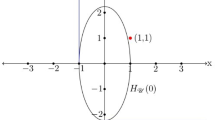Abstract.
The stability number α(G) for a given graph G is the size of a maximum stable set in G. The Lovász theta number provides an upper bound on α(G) and can be computed in polynomial time as the optimal value of the Lovász semidefinite program. In this paper, we show that restricting the matrix variable in the Lovász semidefinite program to be rank-one and rank-two, respectively, yields a pair of continuous, nonlinear optimization problems each having the global optimal value α(G). We propose heuristics for obtaining large stable sets in G based on these new formulations and present computational results indicating the effectiveness of the heuristics.
Similar content being viewed by others
Author information
Authors and Affiliations
Additional information
Received: December 13, 2000 / Accepted: September 3, 2002 Published online: December 19, 2002
RID="★"
ID="★" Computational results reported in this paper were obtained on an SGI Origin2000 computer at Rice University acquired in part with support from NSF Grant DMS-9872009.
Key Words. maximum stable set – maximum clique – minimum vertex cover – semidefinite program – semidefinite relaxation – continuous optimization heuristics – nonlinear programming
Mathematics Subject Classification (2000): 90C06, 90C27, 90C30
Rights and permissions
About this article
Cite this article
Burer, S., Monteiro, R. & Zhang, Y. Maximum stable set formulations and heuristics based on continuous optimization. Math. Program., Ser. A 94, 137–166 (2002). https://doi.org/10.1007/s10107-002-0356-4
Issue Date:
DOI: https://doi.org/10.1007/s10107-002-0356-4




